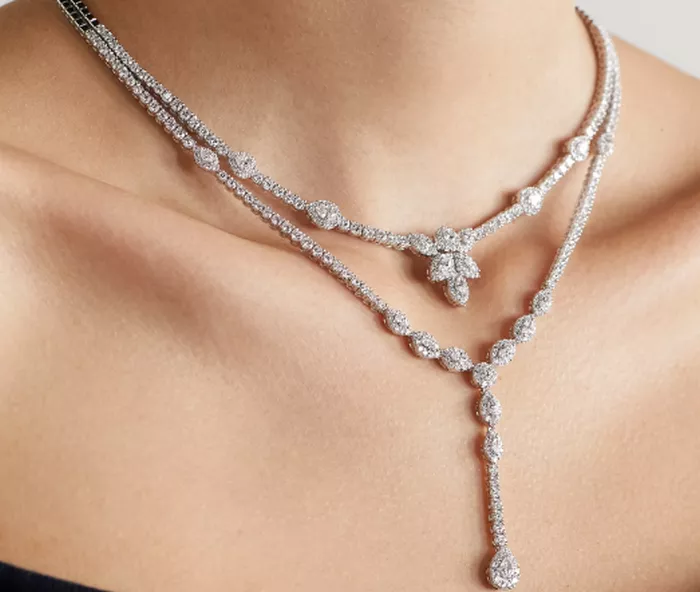Selling a diamond necklace can be a significant decision, whether driven by financial need, a desire to upgrade, or simply a change in personal taste. It involves understanding the value of your necklace, finding the right buyer or platform, navigating the selling process, and ensuring a fair transaction. This comprehensive guide explores the steps involved in selling a diamond necklace, from evaluating its worth to selecting the best selling method, and provides insights into maximizing value while ensuring a smooth and secure transaction.
Understanding the Value of Your Diamond Necklace
Before embarking on the selling journey, it’s crucial to assess the value of your diamond necklace. Several factors influence its worth:
Diamond Characteristics: Evaluate the 4Cs—cut, color, clarity, and carat weight—of the diamonds in your necklace. Diamonds with higher grades in these categories generally command higher prices due to their rarity and quality.
Metal Content: Consider the metal type and purity of the necklace’s setting. Precious metals like gold, platinum, or silver contribute to the overall value, with higher purity metals typically fetching better prices.
Brand and Design: Designer or branded diamond necklaces may hold additional value due to brand reputation, craftsmanship, and exclusivity of the design.
Condition: The condition of the necklace affects its resale value. Well-maintained necklaces with minimal wear and tear generally fetch higher prices compared to those showing signs of damage or needing repairs.
Steps to Sell Your Diamond Necklace
1. Obtain an Appraisal
Professional Appraisal: Seek an appraisal from a certified gemologist or reputable jewelry appraiser. The appraiser will assess the diamonds, metal, and overall condition of the necklace to determine its current market value.
Appraisal Documentation: Obtain a detailed appraisal report that includes descriptions of the diamonds, metal composition, and an estimated resale value. This documentation serves as a valuable asset when negotiating with potential buyers or selling platforms.
See Also: 10 Best Men’s Gold Cross Necklaces in 2024
2. Research Market Prices
Market Research: Research current market prices for similar diamond necklaces to gauge the potential resale value. Online marketplaces, auction houses, and jewelry stores can provide insights into pricing trends and competitive pricing strategies.
Consider Demand: Evaluate market demand for diamond necklaces similar to yours. Factors such as style, design trends, and consumer preferences can influence the perceived value and saleability of your necklace.
3. Explore Selling Options
Local Jewelry Stores: Visit local jewelry stores or pawnshops that buy pre-owned jewelry. Some stores may offer immediate cash offers based on their assessment of the necklace’s value.
Online Marketplaces: Platforms like eBay, Craigslist, or specialized jewelry resale websites allow you to list your diamond necklace for sale directly to potential buyers. These platforms offer visibility to a broader audience but may require effort in terms of listing, communication, and shipping.
Auction Houses: Consider consigning your diamond necklace to reputable auction houses specializing in jewelry auctions. Auctions can attract collectors and buyers willing to pay competitive prices for high-quality jewelry.
Jewelry Buyers and Dealers: Contact professional jewelry buyers or dealers who specialize in purchasing pre-owned diamonds and jewelry. These buyers often provide competitive offers based on market value and may facilitate a straightforward selling process.
4. Prepare Your Necklace for Sale
Clean and Polish: Present your diamond necklace in its best condition by cleaning and polishing it before showcasing or photographing it for potential buyers.
Documentation: Gather all relevant documentation, including the original purchase receipt, appraisal report, and any certificates of authenticity or diamond grading reports, to substantiate the necklace’s value and provenance.
5. Negotiate and Finalize the Sale
Negotiation: Be prepared to negotiate the sale price with potential buyers or selling platforms. Consider the initial offers in relation to your appraisal value and market research findings to ensure a fair transaction.
Secure Payment: Ensure payment security by opting for secure payment methods such as bank transfers, cashier’s checks, or using reputable online payment platforms that offer buyer and seller protection.
Transfer of Ownership: Upon finalizing the sale, complete all necessary paperwork and formalities to transfer ownership of the diamond necklace to the buyer. Obtain a sales receipt or agreement outlining the terms of the sale for your records.
Tips for Maximizing the Sale of Your Diamond Necklace
Timing: Consider selling during peak seasons or holidays when demand for jewelry tends to be higher, potentially maximizing your chances of securing a favorable sale price.
Presentation: Invest in professional photography or showcase your diamond necklace in natural light to highlight its brilliance and attractiveness in online listings or advertisements.
Transparency: Provide accurate descriptions and disclose any relevant information about the necklace’s condition, history, or enhancements to build trust with potential buyers.
Patience: Selling high-value items like diamond necklaces may take time. Be patient and open to considering multiple offers to achieve the best possible sale outcome.
Conclusion
Selling a diamond necklace involves careful planning, evaluation, and consideration of various factors to ensure a successful transaction. By understanding the value of your necklace, conducting thorough research, exploring different selling options, and preparing effectively, you can navigate the selling process with confidence and maximize the value of your asset. Whether you choose to sell through local jewelry stores, online platforms, auction houses, or to professional jewelry buyers, the key lies in leveraging your knowledge and resources to achieve a fair and rewarding sale. With strategic preparation and diligence, selling your diamond necklace can be a fulfilling experience that allows you to capitalize on its value while finding the right buyer who appreciates its beauty and craftsmanship.

